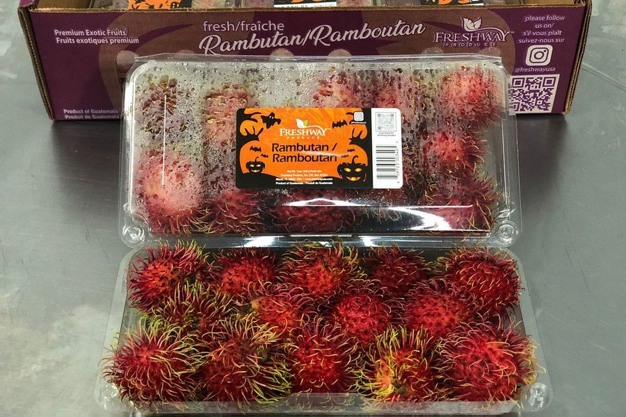September and October are big months for rambutan as three countries are supplying the United States with fruit. Guatemala, Honduras, and Mexico are all in season this time of year. Harvest out of Honduras started three weeks ago and harvest in the region of Puerto Barrios in Guatemala also started up recently. Depending on the weather, supply from both countries could be available through December, or even into January.
As the seasons of many domestic summer items like cherries and stone fruit have ended or are coming to a close, ample availability of rambutan offers retailers an opportunity to consider this item for their fall displays. "Timing for promotions is perfect as rambutan has become increasingly trendy, partly driven by social media," says Jose Roggiero with Freshway Produce. One influencer created a YouTube video about a clamshell of rambutan he had purchased, and it received over seven million views. Influencers are also discussing on social media how to eat a rambutan, what the flavor is like, and some provide recipes. "Social media is where products are recognized these days," commented Roggiero.

Intriguing fruit variety
What makes rambutan trendy? "It is an intriguing fruit that appeals to people because it looks different, and it is very colorful." Once consumers get educated, they find out rambutan is very tasty and easy to peel. While the oriental demographic has traditionally been the largest consumer of rambutan, it is the younger demographic that is nowadays particularly interested in trying out this exciting fruit variety.
"While rambutan is still intriguing, it has already made the transition from exotic to mainstream," according to Roggiero. But what makes an item mainstream? "In my view, that's the case when it is no longer seen as a total novelty because it is increasingly available at local retailers. The stores that aren't carrying the item yet, are at least considering putting it on the shelf."

Short supply chain
Demand for rambutan has consistently increased in recent years. To prevent disappointment, it is important to give it careful treatment throughout the supply chain. The fruit is highly perishable, and it is crucial to keep it in cold storage to preserve freshness and shelf-life. "We specialize in exotic items and purposely carry a limited selection of exotic fruits as we want to be experts in handling each fruit item we carry," commented Roggiero. "One of our advantages is that we're based in Miami. The transit time for product from Central America is very short and in addition, our facility is less than five miles away from Miami International Airport. This is all beneficial in maintaining the cold chain." In addition, we also import through Texas and California, aiming to deliver products to the retailer's distribution center anywhere in the U.S. within 48 to 72 hours after harvest.
Click below to learn more about the harvest and the short supply chain of rambutan from Guatemala to Freshway's distribution center in Miami.
 For more information:
For more information:
Jose Roggiero
Freshway Produce Inc.
[email protected]
www.freshwayusa.com
